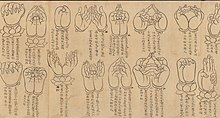
Back المودرا Arabic Mudra BCL Мудра Bulgarian মুদ্রা (ভঙ্গিমা) Bengali/Bangla Mudra Catalan Mudra Czech Mwdra Welsh Mudra German Mudra Spanish Mudra Estonian



A mudra (/muˈdrɑː/ ⓘ; Sanskrit: मुद्रा, IAST: mudrā, "seal", "mark", or "gesture"; Tibetan: ཕྱག་རྒྱ་, THL: chakgya) is a symbolic or ritual gesture or pose in Hinduism, Jainism and Buddhism.[1] While some mudras involve the entire body, most are performed with the hands and fingers.[2]
As well as being spiritual gestures employed in the iconography and spiritual practice of Indian religions, mudras have meaning in many forms of Indian dance, and yoga. The range of mudras used in each field (and religion) differs, but with some overlap. In addition, many of the Buddhist mudras are used outside South Asia, and have developed different local forms elsewhere.
In hatha yoga, mudras are used in conjunction with pranayama (yogic breathing exercises), generally while in a seated posture, to stimulate different parts of the body involved with breathing and to affect the flow of prana. It is also associated with bindu, bodhicitta, amrita, or consciousness in the body. Unlike older tantric mudras, hatha yogic mudras are generally internal actions, involving the pelvic floor, diaphragm, throat, eyes, tongue, anus, genitals, abdomen, and other parts of the body. Examples of this diversity of mudras are Mula Bandha, Mahamudra, Viparita Karani, Khecarī mudrā, and Vajroli mudra. These expanded in number from 3 in the Amritasiddhi, to 25 in the Gheranda Samhita, with a classical set of ten arising in the Hatha Yoga Pradipika.
Mudra is used in the iconography of Hindu and Buddhist art of the Indian subcontinent and described in the scriptures, such as Nātyaśāstra, which lists 24 asaṁyuta ("separated", meaning "one-hand") and 13 saṁyuta ("joined", meaning "two-hand") mudras. Mudra positions are usually formed by both the hand and the fingers. Along with āsanas ("seated postures"), they are employed statically in the meditation and dynamically in the Nāṭya practice of Hinduism.
Hindu and Buddhist iconography share some mudras. In some regions, for example in Laos and Thailand, these are distinct but share related iconographic conventions.
According to Jamgön Kongtrül in his commentary on the Hevajra Tantra, the ornaments of wrathful deities and witches made of human bones (Skt: aṣṭhimudrā; Wylie: rus pa'i rgyan phyag rgya) are also known as mudra "seals".[3]
- ^ Encyclopædia Britannica. (2010). "mudra (symbolic gestures)". Retrieved October 11, 2010.
- ^ "Word mudrā on Monier-William Sanskrit-English on-line dictionary: "N. of partic. positions or intertwinings of the fingers (24 in number, commonly practised in religious worship, and supposed to possess an occult meaning and magical efficacy Daś (Daśakumāra-carita). Sarvad. Kāraṇḍ. RTL. 204; 406)"". Archived from the original on 2012-12-03. Retrieved 2012-05-13.
- ^ Kongtrul, Jamgön (author); (English translators: Guarisco, Elio; McLeod, Ingrid) (2005). The Treasury of Knowledge (shes bya kun la khyab pa’i mdzod). Book Six, Part Four: Systems of Buddhist Tantra, The Indestructibe Way of Secret Mantra. Bolder, Colorado, USA: Snow Lion Publications. ISBN 1-55939-210-X (alk.paper) p.493